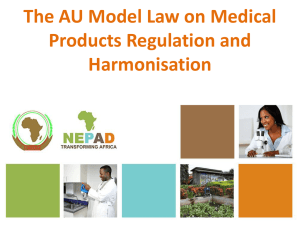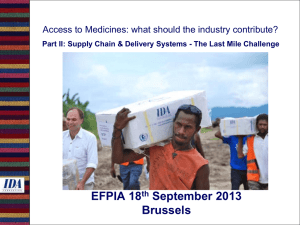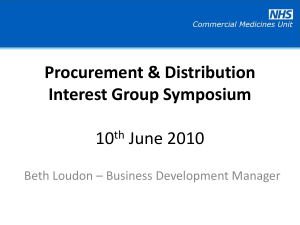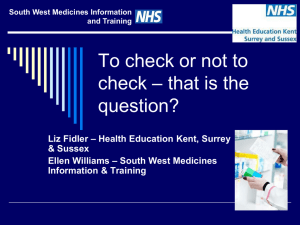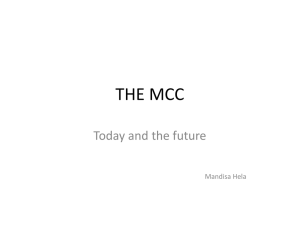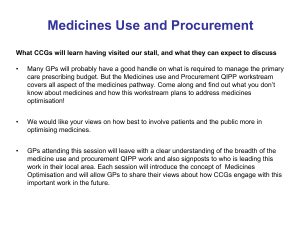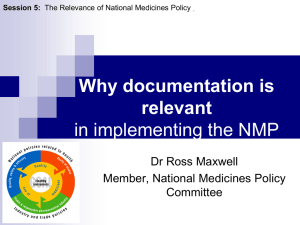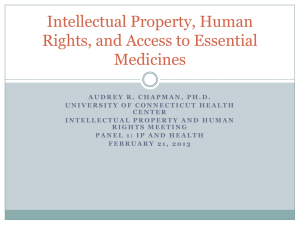pdig_presentation
advertisement
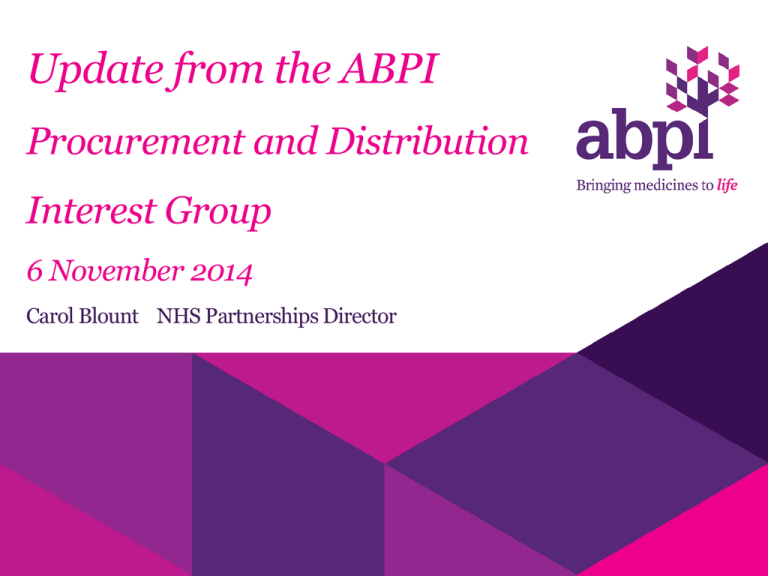
Update from the ABPI Procurement and Distribution Interest Group 6 November 2014 Carol Blount NHS Partnerships Director PPRS context Since the 1950s, PPRS has been negotiated between Department of Health (DH) on behalf of all 4 nations and the ABPI, on behalf of the UK researchbased industry • For DH as the primary negotiator on medicines in the UK, DH needs to ensure medicines are available at reasonable prices whilst the environment remains positive for the biopharmaceutical industry • For Industry, the scheme recognises the need to ensure patients have access to the medicines they need and that the Industry remains profitable to enable on going investment in research and development 2 2014 PPRS Context At the time of negotiation of PPRS, both sides recognised the challenge UK austerity, debt and rising healthcare costs Low and slow uptake of newer medicines, but lowest prices in Europe Importance of life sciences industry and R&D to the UK economy Stability required for the longer term for both industry and Government 3 Understanding the PPRS Previous PPRS have featured price cuts, so NHS benefits from lower prices but spend increased The 2014 scheme underwrites the overall growth in spend by the NHS on branded medicines within the scheme Industry is a committed partner with NHS across the UK Supports patients and clinicians access to newer medicines Five-year agreement covering 2014-2018 Commitments to dialogue on NICE and uptake Vast majority (90%+) of branded medicines included in the scheme 4 Majority of Branded products are in PPRS PPRS includes 93% of UK branded medicines by value (Jan 2014 data): 98% of all Branded medicines spend in Primary Care 87% of Branded medicines spend in Secondary Care It doesn’t include.. • Exceptional central procurements (national stockpiles, pandemic preparation) • Procurements of centrally supplied vaccines • Parallel imports or exports 5 New five year pricing agreement caps the medicines bill for the first time The deal Estimated payments c£4b “This agreement ensures NHS patients will receive the best and most advanced medicines in the world while managing the cost. UK pharmaceutical companies have responded to the challenges we face as a country, both in terms of the increased demand for medicines and pressure on public spending.” Jeremy Hunt, Health Secretary, Department of Health press release, 6th November 2013 6 Q2 data published by DH Q2 Payment: £76M, YTD Growth: 5.52% £000's Q1 2013 Q2 2013 Q3 2013 Q4 2013 Q1 2014 Q2 2014 Growth Aggregate Net Sales Subject to Medicines Bill Growth Calculation (Measured Spend) 1,865,113 1,943,105 2,012,318 2,151,675 1,985,170 2,033,106 Aggregate Net Sales Covered by the PPRS payment 1,865,113 1,943,105 2,012,318 2,151,675 1,982,636 2,024,576 Aggregate Payment received by DH 74,000 76,000 YTD Q1 1,865,113 1,985,170 6.44% New products launched after the start of the scheme account for 0.275% of measured spend YTD, vs forecast of 0.47%. YTD Q2 3,808,218 4,018,276 5.52% Q2 alone 4.63% 7 PPRS Forecast and payments 2014 2015 2016 2017 2018 Initial forecast Growth Rate of Measured Spend (F%) 3.87% 3.52% 3.86% 2.14% 3.09% Allowed Growth Rate of Measured Spend (AGR) 0% 0% 1.8% 1.8% 1.9% Initial forecast of New Products Share of Measured Spend (NP%) 0.47% 1.85% 3.37% 5.13% 7.01% Initial annual payment percentage (P%1) 3.74% 7.13% 9.92% 9.92% 9.92% Estimated future annual payment percentages (2015-2018) (FP%2, FP%3, FP%4, FP%5) 8 2015 2014 Timelines: 30 Apr 14 2014 Q1 Sales Report + Payment 18 June 14 Q1 data published 31 July 14 2014 Q2 Sales Report + Payment 12 Sept 14 Q2 data published 31 Oct 14 2014 Q3 Sales Report + Payment Early Dec 14 Q3 data published + 2015 % Payment set & communicated 31 Jan 15 2014 Q4 Sales Report + Payment 30 Apr 15 2015 Q1 Sales Report + Payment 31 July 15 2015 Q2 Sales Report+ Payment 30 Sept 15 2014 Annual Sales Report submitted 31 Oct 15 2015 Q3 Sales Report + Payment Nov 15 2016 % Payment set & communicated 9 NHS communication on PPRS: “The NHS and pharmaceutical industry have a mutual interest to ensure patients can access cost and clinically effective innovative medicines and can optimise the use of these medicines to achieve better outcomes” “NHS England, DH and the ABPI are continuing to work collaboratively to ensure that the NHS maximises the opportunities offered by the Agreement” 10 Industry and NHS England partnership What is industry doing? Committed to improving access for patients across the UK through this deal and through negotiated access schemes Significant payments made, industry commitment to the NHS New joint NHS England /ABPI PPRS/Medicines Optimisation programme to drive change Supporting Innovation, Health and Wealth Unanswered questions • • • • Could PPRS payments go directly to commissioners / budget holders to support uptake of new medicines? How can PPRS encourage an end to rationing of innovative medicines? How to improve transparency and accountability on the use of new medicines via one set of metrics? How to focus on value and outcomes, not on short term costs alone 11 PPRS provides a one-off opportunity Patients and clinicians the PPRS provides an opportunity to find the right level of usage of branded medicines, based on clinical factors rather than cost For the NHS, medicines bill growth has been underwritten, so commissioners can remove barriers to clinicians choosing which medicines to use For industry: PPRS gives a level of stability and supports innovative companies, but need to change access and uptake of innovative medicines For Government and the taxpayer: PPRS achieves predictability on the branded medicines bill through this period 12 PPRS/Medicines Optimisation programme ABPI: NHSE joint programme aims: 1. To improve patient outcomes, quality and value of care from medicines use 2. To maximise the benefits of the PPRS through a joint programme of action 3. To accelerate uptake of innovative, clinically effective and cost effective medicines 4. To create clinical pull for patient access to these medicines Medicines optimisation MO dashboard joint venture, patient panel Access and uptake of innovation including IHW commitments , a combined national metrics report, Pilot of 90 day tariff Specialised commissioning Impact of MO on specialised commissioning, joint work on Commissioning through Evaluation Communications and engagement NHSE/ABPI regional road shows, joint communications, ABPI Therapy Groups working with NCDs Governance: PPRS/MO steering group: NHSE, ABPI, AHSNs, RPS, RCN, CCGs, BGMA, DH 13 Medicines Optimisation Guidance Medicines Optimisation – intended outcomes Principle 1 Aim to understand the patient’s experience Patients are more engaged, understand more about their medicines and are able to make choices, including choices about prevention and healthy living Patients’ beliefs and preferences about medicines are understood to enable a shared decision about treatment Patients are able to take/use their medicines as agreed Patients feel confident enough to share openly their experiences of taking or not taking medicines, their views about what medicines mean to them, and how medicines impact on their daily life Principle 2 Evidence based choice of medicines Optimal patient outcomes are obtained from choosing a medicine using best evidence (for example, following NICE guidance, local formularies etc) and these outcomes are measured Treatments of limited clinical value are not used and medicines no longer required are stopped Decisions about access to medicines are transparent and ain accordance with the NHS Constitution Medicines Optimisation – intended outcomes Principle 3 Ensure Medicines use is as safe as possible Incidents of avoidable harm from medicines are reduced Patients have more confidence in taking their medicines Patients feel able to ask healthcare professionals when they have a query or difficulty with their medicines Patients remain well and there is a deduction in admissions and readmissions to hospitals related to medicines usage Patients discuss potential side-effects are there is an increase in reporting to the Medicines and Healthcare products Regulatory Agency (MHRA) Patients take unused medicines to community pharmacies for safe disposal Principle 4 Make medicines optimisation part of routine practice Patients feel able to discuss and review their medicines with anyone involved in their care Patients receive consistent messages about medicines because the healthcare team liaise effectively It becomes routine practice to signpost patients to further help with their medicines wand to local patient support groups Inter-professional and inter-agency communication about patients’ medicines is improved Medicines wastage is reduced The NHS achieves greater value for money invested in medicines The impact of medicines optimisation is routinely measured. ABPI Regional Partnership Managers Team • 4 Regional Partnership Managers aligned to the 4 regions in England • Harriet Lewis (North); Andy Riley (Midlands and East); Hasseena Winter (London) • Diana Vegh (South) RPM Purpose: •To be the regional face of Industry and position Industry as a partner to the NHS and an integral part of the solution •Responsible for shaping and improving the regional environment for Industry, to improve patient outcomes by enabling patient access to and optimum usage of innovative medicines •Develop and establish strong, sustainable relationships with key regional NHS stakeholders and member companies RPM Primary focus 2015 : Implementation of nationally agreed policies at a regional level (eg IHW, MO) Delivery of the joint PPRS/Medicines optimisation programme at a regional level to: • • • • Improve patient outcomes, quality and value of care from appropriate medicines use Maximise the benefits of the new PPRS scheme through a joint programme of action Accelerate uptake of clinically effective and cost effective branded medicines Create clinical pull for patient access to these medicines Current Industry : AHSN Medicines Optimisation collaborations NHS Organisation description NENC AHSN communication transfer at interface, medicines review in care homes /improve use of Respiratory COPD medicines Projected Outcomes / Measures of Success Reduction of medication errors for vulnerable patients Improved outcomes for patients with respiratory conditions NENC AHSN Programme of work led by NE Quality Observatory. adoption of NICE TAs without barriers Y&H AHSN Diabetes care pathway review adoption of NICE TAs Y&H AHSN Anticoagulation service redesign improved anticoagulation provision and access to appropriate medicines in accordance with NICE GMAHSN Adoption of integrated framework for rapid and effective implementation of NICE TAs Validation and roll out of framework developed by Oldham CCG Oxford AHSN Stroke prevention/ adoption of NICE guidance for NOACs To work with IMS on using the most effective treatment for patients with AF and change prescribing behaviour Southampton FT/ Wessex AHSN Reducing harm from alcohol Linking clinical services and commissioners to reduce alcohol related harm WM AHSN Flo tele-health – including adherence support package STARTBACK – stratified care model for back pain Improvements in patient adherence to medicines Eastern AHSN (PRESCQIPP) Build MO programme and IHW work streams Insights into factors which contribute to medicines waste and what can be done to improve adherence and enhance treatment outcome Nottingham Uni Roll out of PINCER across all the practices in East Rushcliff CCG / EM Midlands AHSN working in partnership with the steering group at East Midlands AHSN and support the development of 18 medicines safety infra-structure in primary care Innovation Health and Wealth “NHS England is committed to delivering the recommendations in the Innovation, Health and Wealth Report to improve outcomes for individuals, carers and families” NHS Mandate chapter 7 ‘The broader role of the NHS in society’ “NHS England is committed to ongoing implementation of IHW, which seeks to improve NHS use of innovative treatments for the benefit of patients..” PPRS 2014 chapter 4 The overall expectation is that the IHW refresh would continue to build the strategic direction , update progress and set out next steps, supported by a series of actions and timelines for the next 2-3 years as the next stage in the longer term strategy. Innovation Health and Wealth Refresh Industry proposals 1.Reducing variation and strengthening compliance – continued commitment to the NICE compliance regime •Rapid and consistent implementation of NICE TAs •NICE TA recommendations are incorporated automatically included into relevant local NHS formularies and formularies are published •Continued commitment to and resourcing of the NICE Implementation Collaborative to overcome system wide barriers to implementation of NICE TAs •Development of the Innovation Scorecard into the new combined metrics report 2.AHSNs – continued commitment to fund AHSNs and greater clarity in their role in improving the adoption of innovative medicines is needed 3.Aligning financial , operational and performance incentives – financial incentives should work to encourage early adoption of NICE TAs. •Introduction of an integrated national incentive for improved access and uptake of NICE TAs with sanctions/penalties for organisations found to be blocking or restricting patient access to those medicines. •Align existing incentive schemes •Regular audit of NICE TA implementation and publication of annual Innovation Returns at organisational level •Include IHW as a national priority for inclusion in Quality accounts Innovation Health and Wealth Refresh Industry proposals 4.Increasing responsibility and accountability for IHW from national to local level within the NHS •NHS clinical, operational and financial accountability for IHW delivery needs to be considerably strengthened, from the NHSE Board , through the operational directorate to local levels •Innovation plans and objectives should be set at every level and audited •The IHW Implementation Board should be reconstituted and reinstated including senior level representation of NHSE clinical , operations and finance

